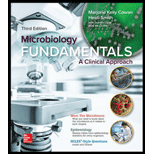
To determine:
The reason that the normal biota of GI tract seems to include a lot of disease-causing organisms.
Introduction:
Gastrointestinal tract or digestive tract is responsible for ingesting and digesting food, absorbing nutrients, and eliminating waste. The alimentary canal is a passage through which the food passes in our body. It includes mouth, esophagus, stomach, small intestine, large intestine, rectum, and anus.
To determine:
The reason that if microbiota are “normal” then why they are called potential pathogens.
Introduction:
The human body is occupied with various non-pathogenic normal microbiota, which prevents the entry of pathogenic microbes. For example, the normal microbiota of Lactobacillus and Staphylococcus among others prevents microbial infection in different body regions.
Want to see the full answer?
Check out a sample textbook solution
Chapter 20 Solutions
Microbiology Fundamentals: A Clinical Approach
- Which of the following bacterial species is considered normal flora of the mouth? O 1) Streptococcus mutans 2) Escherichia coli 3) Klebsiella pneumoniae 4) Staphylococcus epidermidisarrow_forwardWhich of the following statements about listeriosis is false?(a) The causative agent, Listeria monocytogens, can befound in many types of food .(b) When pregnant women are infected with Listeria mono-cytogens, the bacteria may cause fetal damage or death.(c) Bacteriophages can be used to eliminate Listeria oncontaminated food.(d) Infection with Listeria monocytogens rarely results inmeningitis.(e) Listeria L-forms lack cell walls and are able to persistinside of macrophages after phagocytosis.arrow_forwardWhy do you think E. coli and other enteric organisms are common causes of UTIs?arrow_forward
- E.coli is part of the normal microbiota of the intestines and can cause gastroenteritis. Explain why this one bacterial species is both beneficial and harmful.arrow_forwardWhat are the different nonpathogenic atrial / intestinal flagellates that can be found in humans? What extraintestinal flagellate is pathogenic to humans? Compare its pathogenicity in males and females?arrow_forwardSome bacteria, protozoa, and viruses that cause foodborne illness are: E.coli, Salmonella Norovirus Staphylococcus aureus Clostridium botulinum Campylobacter Clostridium perfringens Hepatitis A. Giardia (mainly water) Listeriosis Select two (2) of the foodborne illnesses listed above and report the following information for each. Disease name and whether it is a bacteria, protozoa, or virus Type of contamination (infection or intoxication) Infectious pathway Possible sources and foods affected Symptoms Incubation period Treatment Current Statistics, how many affected, where, when etc.arrow_forward
- Why is it difficult for the colon to reestablish a beneficial flora after several antibiotic treatments?arrow_forwardA child consumed watermelon in a restaurant and was thereafter infected with Esc. coli O157:H7. Investigations revealed that the knife used to slice the melon was also used to cut raw beef (and then washed). What could have been done to prevent the situation?arrow_forwardIn about 250-350 words, address the following: First Part Describe the process of digestion, naming all the organs involved. Describe the process of absorption be sure to differentiate between digestion and absorption Second Part Explain the role of the microbiome Search the internet for a research study on the gut microbiome and its effect on health. Academic Resources. Summarize the study findings, including how many people or animals were studied, what was studied, and the results of the study Cite your source in AMA or APA format at the bottom of your post Organize your post using paragraphs to separate thoughts and ideas.arrow_forward
- Which streptococcal disease is most prevalent? Why do you think this is the case?arrow_forwardA parent calls to ask about giving a medication for diarrhea to his child, 12 years of age, who is recovering from the flu. The nurse expects the prescriber to recommend which medication? a) bismuth subsalicylate (Pepto-Bismol)b )Lactobacillus GG (Culturelle)c )belladonna alkaloid/phenobarbital combination (Donnatal Elixir)d) loperamide (Imodium A-D)arrow_forward125. A 37-year-old man develops a recurrent episode of pseudomembranous colitis shortly after completing an initial course of oral metronidazole therapy. Which of the following best explains the recurrence? A) The bacterial strain can form spores that persist in the gastrointestinal tract B) Other gastrointestinal flora have degraded the metronidazole CC) The patient has an underlying gastrointestinal tract disorder OD) Systemic therapy is necessary to eradicate this infectionarrow_forward
 Human Heredity: Principles and Issues (MindTap Co...BiologyISBN:9781305251052Author:Michael CummingsPublisher:Cengage Learning
Human Heredity: Principles and Issues (MindTap Co...BiologyISBN:9781305251052Author:Michael CummingsPublisher:Cengage Learning
